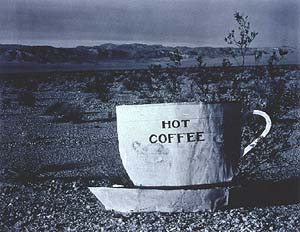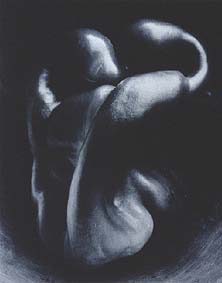
Edward Weston and
the "M" Word
I went to the Phillips Collection looking for help. My problem is the "m" word: modernism. I have dedicated a considerable amount of my adult life trying to understand that word. I have studied it, lectured on it, and written about it. I have graded students on their ability to discuss it. I have even taught an entire seminar on the subject, the course title now linking the word permanently to my name in the Johns Hopkins 2001-2002 course catalogue as well as in the memories of the twenty four students who took my class. Yet I still cannot define the word. I have no confidence that I really know what it is. Worse, I am not convinced that it means anything whatsoever. I fear the day when a student will challenge me, and I will be revealed as a charlatan. So when I read about the opening of "Edward Weston: Photography and Modernism" at the Phillips Collection ("America's First Museum of Modern Art"), I decided that the $7.50 admission fee was a small price to pay for having modernism explained to me once and for all.
As an historian I take some solace in the fact that none of my betters - here defined as anyone who actually has a successful academic career - seem any more capable of defining modernism than I. Even Peter Gay, the most successful intellectual historian alive today, a man whose reputation derives largely from books about modernism, is unable to pin down what he means by the term and make his definition stick. Gay defines modernism loosely as a revolt against bourgeois values, which is fine if "bourgeois" really meant anything. (Gay has written numerous books on that topic, too, without ever defining it.) I guess we all know what "bourgeois" means just as we understand "beauty," "freedom," and "middle class." But in truth these words suggest more than they actually mean. Maybe their power lies in their indeterminacy.
 Looking at Weston's exquisite photographs, masterfully executed studies of line, curve, and texture,
I recalled Gay's description of modernism and realized that most of the attributes he ascribed to the word, things having to do with politics and broad cultural trends, were irrelevant to the work in front of me. The brief explanations and labels posted by the museum curators made matters worse, for the very frequency with which they use "modernism" betrays the emptiness of the word. The curators indolently pretend that we, the museum visitors, know what the word means so that they, the curators, do not have to go to the trouble of explaining themselves. And every sentence begs the most terrifying question of all: what does "modern" mean? Early placards inform us that Weston
was greatly impressed when he first saw "modern European paintings," he "made his first photographs of modern industry,"
he was exposed to "such modern artists as...," etc. Subsequent placards proclaim, "Weston
looked back on this time as one of transition, during which he emerged as a mature
modernist," his work "places him at the center of American modernism,"
and, finally, Weston moved beyond the "high-modernist formalism that had dominated his work up until now." Good grief.
Looking at Weston's exquisite photographs, masterfully executed studies of line, curve, and texture,
I recalled Gay's description of modernism and realized that most of the attributes he ascribed to the word, things having to do with politics and broad cultural trends, were irrelevant to the work in front of me. The brief explanations and labels posted by the museum curators made matters worse, for the very frequency with which they use "modernism" betrays the emptiness of the word. The curators indolently pretend that we, the museum visitors, know what the word means so that they, the curators, do not have to go to the trouble of explaining themselves. And every sentence begs the most terrifying question of all: what does "modern" mean? Early placards inform us that Weston
was greatly impressed when he first saw "modern European paintings," he "made his first photographs of modern industry,"
he was exposed to "such modern artists as...," etc. Subsequent placards proclaim, "Weston
looked back on this time as one of transition, during which he emerged as a mature
modernist," his work "places him at the center of American modernism,"
and, finally, Weston moved beyond the "high-modernist formalism that had dominated his work up until now." Good grief.
|
|
Images:
Edward Weston, "Hot Coffee," Mojave Desert (1937), Lane Collection, Museum of Fine Arts, Boston
Edward Weston, Pepper (1930), Lane Collection, Museum of Fine Arts, Boston



film politics music jay's head poetry art josh ring saddies about archive